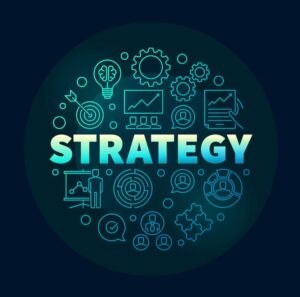How the Right IT Strategy Can Explode Your Business Growth
May 13, 2025

As a small-to-medium business owner, you’re probably juggling a lot of hats. You’re focused on sales, customer service, operations, and yes, IT (whether you love it or not). But what if I told you that the right IT strategy could be the secret ingredient to unlocking massive growth for your business? Let me share how aligning your IT systems with your business goals can take you from surviving to thriving in today’s competitive market.
Why IT Strategy Matters for Small-to-Medium Businesses
Let’s face it—technology is no longer just an afterthought. It’s the backbone of every successful business today. If you don’t have a solid IT strategy, you’re probably facing inefficiencies, security risks, and missed opportunities. Trust me, I’ve seen it firsthand.
I once worked with a small business owner who ran a retail store with 50 employees. They were growing fast but struggled to keep up with inventory, sales reporting, and customer engagement. They were using outdated systems and spreadsheets, which resulted in errors and delays. After we implemented an integrated IT strategy, including cloud-based inventory management and customer relationship management (CRM) software, their sales efficiency improved by 25%. The employees were happier, and so were their customers. The business owner now had more time to focus on growth, not manual processes.
But how do you get started with building an IT strategy that drives business growth?
Key Elements of a Winning IT Strategy
Here’s the thing: Your IT strategy shouldn’t be one-size-fits-all. It needs to align with your specific business goals. Whether you’re trying to scale, enhance customer experience, or protect your data, your IT systems should support these objectives. Let’s break down the core elements of a strategy that can take your business to the next level.
- Align IT With Your Business Goals
This might seem like an obvious one, but you’d be surprised how many businesses operate with IT that’s disconnected from their overall objectives. Your IT strategy should empower your team and align directly with your growth ambitions. Are you looking to improve customer service? Scale operations? Automate processes?
For example, when I helped a logistics company with 200 employees, their main challenge was managing deliveries and tracking orders. By aligning their IT strategy with the goal of improving delivery times and customer satisfaction, we introduced a fleet management software integrated with real-time GPS and mobile apps for drivers. The result? Faster deliveries and a 30% boost in customer satisfaction, driving repeat business.
- Security and Risk Management
In today’s digital age, security is no longer optional. The right IT strategy must include a robust security framework to protect your business and customers. Small-to-medium businesses are often targets for cyberattacks, and a single breach can be catastrophic.
I worked with another business in the healthcare sector where patient data was at risk because their systems were outdated and unsecured. After we implemented advanced encryption, secure data backups, and employee training on phishing prevention, their security posture improved dramatically. Not only did they avoid costly breaches, but their patients felt more confident about their data’s safety.
- Scalability and Flexibility
As your business grows, your IT needs will evolve. That’s why scalability should be a key consideration when building your strategy. You need systems that can grow with you, not slow you down.
I once helped a software company scale up from 100 employees to 300. They were using an on-premise server setup that quickly became a bottleneck as their business expanded. By migrating their operations to the cloud, they were able to scale easily and avoid expensive hardware upgrades. The flexibility of cloud solutions allowed them to add new tools and services quickly, with no downtime.
- Data Management and Analytics
The right IT strategy helps you make better decisions by using data to inform your strategy. Whether it’s customer data, sales trends, or operational insights, having a solid data management plan is essential.
Take my experience with a marketing agency that struggled with tracking campaign performance across various platforms. They had no centralized system to pull all the data together, leading to confusion and inefficiency. We implemented a data management platform that aggregated all their marketing analytics in one place. This allowed them to quickly optimize campaigns based on real-time data, resulting in a 20% increase in ROI within three months.
- Automation and Efficiency
No one likes to do repetitive tasks, and with the right IT strategy, you don’t have to. Automating processes can save time and money, allowing your team to focus on high-value work. From invoicing and payroll to customer follow-ups, automation can streamline your operations significantly.
One of my clients, a small manufacturing company, was manually entering production data into spreadsheets, which was incredibly time-consuming. We helped them implement an automated system for tracking inventory and production, which reduced human error and saved them over 100 hours per month in manual labor. That time savings allowed them to focus on product innovation and customer growth.

Implementing Your IT Strategy: The Step-By-Step Process
You’re probably wondering: Where do I start?
Building and executing an IT strategy might seem daunting, but it doesn’t have to be. Here’s a simple, actionable process:
Step 1: Assess Your Current IT Setup
Take a good, hard look at your existing IT systems and processes. Are they helping or hindering your business goals? Conduct an IT audit to identify gaps and inefficiencies. Are there security vulnerabilities? Is your current infrastructure scalable?
Step 2: Define Clear Business Objectives
Your IT strategy needs to directly support your business goals. Do you want to improve customer service? Increase productivity? Expand into new markets? Define your objectives, and make sure your IT systems are designed to achieve them.
Step 3: Choose the Right Tools and Technologies
Once you know what you need, it’s time to choose the right tools and technologies. This could be anything from CRM systems to cloud infrastructure or cybersecurity solutions. I recommend starting small and scaling as you grow, so you don’t overwhelm your resources.
Step 4: Invest in Your People
Your employees will be the ones using the technology day in and day out, so investing in training is crucial. Make sure your team understands the tools and systems they’re using to maximize productivity and efficiency.
Step 5: Continuously Evaluate and Adjust
Technology changes quickly, and your business will too. Your IT strategy should evolve alongside your business goals. Regularly review performance, gather feedback from your team, and make adjustments as necessary.
Overcoming Common Challenges in IT Strategy Implementation
Even with the best-laid plans, there are common challenges SMBs face when implementing an IT strategy. Here are a few tips to help you overcome them:
- Budget Constraints
It’s true that technology can be expensive, but there are always cost-effective solutions for SMBs. Cloud services, open-source tools, and software-as-a-service (SaaS) platforms can provide enterprise-level capabilities at a fraction of the cost. You don’t need to break the bank to build an effective IT strategy.
- Lack of In-House IT Expertise
If you don’t have an IT expert on staff, consider outsourcing to a consultant or managed services provider. They can guide you through the process, ensuring you make the right decisions for your business.
- Resistance to Change
Change can be tough, especially when it involves technology. To ease the transition, involve your employees early in the process, provide adequate training, and emphasize the benefits of the new systems.

Final Thoughts
A well-executed IT strategy can do wonders for your business growth. It can help you scale, streamline operations, improve security, and make smarter decisions. But it’s not a one-size-fits-all approach—every business is unique, and your IT strategy should be tailored to fit your specific goals.
So, whether you’re just starting to build your IT strategy or looking to optimize an existing one, remember: the right tools, the right people, and the right approach can take your business to new heights. Don’t wait for your competitors to get ahead, contact Cocha Technology, take control of your IT strategy today and watch your business thrive!
Recent Posts
Have Any Question?
Call or email Cocha. We can help with your cybersecurity needs!
- (281) 607-0616
- info@cochatechnology.com



